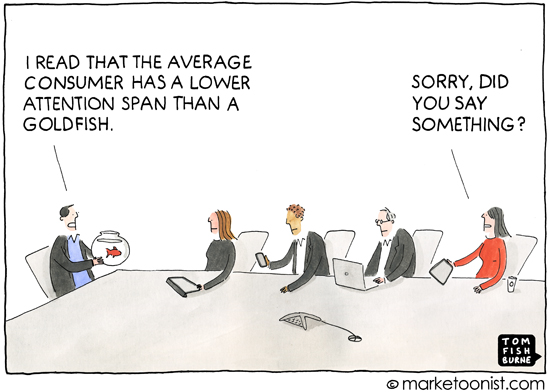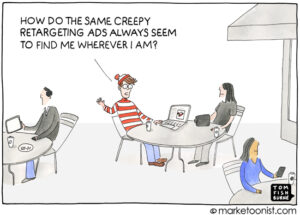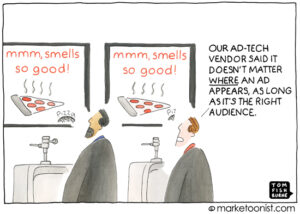In 2000, the attention span of the modern consumer was 12 seconds. It’s now 8 seconds. The average attention span of a goldfish is 9 seconds.
Marketers are in the business of trying to catch (and hold) people’s attentions. That has always been a challenge. But it’s only getting harder.
Thus the the trend toward “snackable content”, a marketing buzzword for breaking marketing communication into really small engaging pieces. The rise of infographics and of videos that can fit into a 6-second Vine are part of this trend. Marketers are experimenting with a lot of ways to produce short attention span theatre.
But I don’t think “snackable content” is just about brevity. What sometimes gets overlooked is the importance of taking a serial approach to content. Rather than an isolated one-off (like an infographic), I think that content should be thought of as mini-series, where each piece may be bite-sized, but over time, there’s a common thread. If the content is good enough, people look forward to the next installment.
My favorite example of this is still Oreo’s 100-day “Daily Twist” campaign from two years ago. To celebrate Oreo’s 100th anniversary, Oreo released a new image every day combining an image of their cookie with a spin on pop culture, from Gay Pride to Elvis Week to the anniversary of Pong. Leave it to a snack brand to nail snackable content.
This is one of the things I love about the medium of cartoons. Our content marketing studio has been working on a fun project with Google to help introduce a new book from Eric Schmidt and Jonathan Rosenberg. We parsed out 15 of the top insights from their book, How Google Works, and then illustrated them in cartoons that they shared, two a week, leading up to the book launch.
Cartoons have always have a serial dimension to them (Peanuts ran daily for 50 years). But I think that the “serial” dimension can extend to any form of content.
As marketers, we can’t fight the incredibly shrinking consumer attention span. It just forces us to get better at telling our story, and connecting with our audiences in ways that matter to them.
(Marketoonist Monday: I’m giving away a signed cartoon print. Just share an insightful comment to this week’s post by 5:00 PST on Monday. Thanks!)



Ori Pomerantz says
We live in an ADHD culture. We are exposed to so much information, we can’t process most of it. You’re definitely right about the serial aspect, though – good insight.
May I quote from my book, “Lying with Memes”?
Two hundred years ago almost all people worked on farms. This meant they spent most of their time with same people, talking about the same subjects, and mostly reading the same few books the family had (often they only had a Bible).
A hundred years ago, in the wake of the industrial revolution, most people lived in cities. They could go to libraries that had thousands of books, talk with strangers, and in general have access to a lot more information. But it was not convenient. After a long day working on the assembly line, who has the energy to go into the library, even if it would still be open for a couple of hours?
Fifty years ago people could sit in their living rooms, listen to one of a few radio stations, and maybe watch a channel or three of television. But the choice was still limited to whatever was broadcast at the time, or the records they had bought. Books were cheap, but again people were limited to the ones they had around.
Today we have the Internet. Web pages from every organization and group in the world are only a Google search away. More hours of video on Youtube and pages of books on Amazon than you could could consume in hundred lifetimes, streamed right into a device that fits in your pocket.
With so much information available, we cannot look at most of it carefully. Our time and attention are at a premium. In comparison with previous generations, we all have Attention Deficit and Hyperactivity Disorder (ADHD). If something doesn’t grab our attention quickly, we just move on.
Now flip it, look at the problem from the other side. You want to communicate with an audience that suffers from ADHD. If you are lucky, you have five seconds to hook their interest. If you do, maybe thirty seconds until they decide they’re done with you. How do you do it?
Human beings can process pictures very quickly. That was useful when our ancestors either saw the tiger and got away, or didn’t see the tiger and got to be dinner. So memes have a picture. But we are more likely to think and remember words, so memes also include short captions.
Viji Prasad says
The fish comparison is bang on. For time immemorial good storytellers used the “hook” to catch attention. Blurbs on movies and catalogues, images in cave paintings, numbers that stood out. But hardly anyone shared their trade secrets. Media platforms too demanded not just rigour but also credible references. Today media barriers have fallen and tricks of the trade are being shared real time. We are literally building the bridge as we go along.
Have I lost your here? Did I get my 8 seconds? I wonder. ..
Will Fleming says
Another key things to consider about this ADHD society is that we tend to be more black and white about issues and brands than ever before and more interested in honest emotional ads. Less time focusing on things often leads to quick emotional decisions about what to buy or what is right or wrong. We can also be more obsessive about our favorite things once we are hooked becoming huge advocates of brands if you can catch our attention.
Because of the short attention span you may need to make dozens of impressions before you get our attention, but once you do you will probably have a loyal customer if you can tap into our emotions.
John Beasley says
It’s funny how we react to a challenge which presents two possible paths to solve the issue…
Issue: “Modern consumers have less attention span for content”
Option 1: We focus on ‘span’ or time as the key measurement – and therefore adjust and set our goals accordingly – making the content fit the time.
Option 2: What if the measurement was ‘attention’ and demanded therefore that we focus on how to deliver more attention grabbing content, and understanding what would our consumers or fans want to talk about and share with their friends.
Focussing on time risks weakening the content and creating perfectly bite sized spam…
I think serialisation is a fascinating insight, as it encourages content creators to try more, but be willing to cut what doesn’t fly with fans. Take that a step further and Content creators in Action Sports create serialised content by inviting fans to set challenges such as thecomeup.com’s #instagramslam.
Jackie B says
Good comments by the four writers ahead of me. Issue is….who read their comments? 8 seconds means that there is limited reading at best. Sorry Ori, but I don’t know that the average person read your comments – probably took too long!
What about considered thought?
Net:net – yes whether story or cartoon, how to educate may go back to what some of us did in elementary school, repeat, repeat, repeat – though that never gets to deep thought, just shallow routine.
Jennifer Salkeld Nelson says
I first saw the cartoon without the time to read the commentary this morning. Immediately it stuck me as a fabulous, slightly barbed poke at one of the great paradoxes of most large organizations — change comes slow since it’s “hard to turn a tanker” and yet somehow, teams in those large organizations are often frustrated by their management’s seemingly excessively short attention span by not staying the course on a strategy all the way through basic execution — no less time to validly assess impact.
So it was a pleasant surprise to get treated to an entirely different thought provocation — with the bonus of totally deployable, practical advice baked in!
Jason Cormier says
Your post is a great example of why we hired an award-winning infographic artist. It’s an attention deficit economy for sure. The nature of the game for “snackable” content now is visual storytelling that can bridge the gap between actual and desired perceptions.
April says
I think another part to this is that because people have such short attention spans, marketers and agencies need to move away from these weird stories in their TV ads designed to get people’s attention and more so on finding ways to tie their brand to the creative hook earlier in the ad. Nowadays I’ll see an ad that has nothing to do with the brand and then they show it in the last 5 seconds of an ad, and the average consumer will have already lost attention by that point.
Clare Morgan says
Don’t under estimate the intelligence of the goldfish, having a tank of tropical fish at home (not goldfish but still fish…), I have observed that as soon as I go near the tank they all come forward and to the surface for food – whereas when my children go near the tank they are ignored (they never feed them though promised to do so when the tank was purchased!)
The salient lesson from fish observation is repetitive messaging with reward can drive recognition – so agree “snacking content” needs to be consistent – daily if the fish analogy is followed!
Kaylor Hildenbrand says
Messaging in so many forms has been whittled down to a minimal character count – Twitter, text messages, etc. Brevity is praised. Couple that with our instinctual love of discovery (what’s next?) and you can build engagement. Snackable content is likely here to stay.
Danielle says
something something SHORT ATTENTION SPAN something.
I confess I got distracted halfway through and answered 2 emails.
OOoh! I forgot I had that TAB open..
Bob Roach says
“Simplify, simplify.” – David Thoreau
Or…
http://goo.gl/JrlHuy – James Victore
All of Victore’s stuff is masterfully fresh, authentic, concise and powerful. Visceral engagement? It’s not a direction many clients dare take on anymore despite its potential.
Comments on some previous comments:
Building engagement… does it always work at building brand?
Great ideas in few words penetrate strongest. Spoken engages better than print (radio is the most visual medium). Great idea in great copy trumps great visuals with mediocre copy. Even visual-only depends on a connection to great copy — induced, but designed.
Brevity can also go too far. “Too clever is dumb.” (Ogden Nash)
Is shrinking attention a cultural response to too much message, too much ‘attraction’? Consumers need — crave — time and space to think.
With Adblock on, I get less advertising shouting at me in an hour of web browsing than I do when I go for a 15 min walk down the street. Space, time and privacy — when will these be consumer ‘snacks’? Imagine a client paying for public area ad space NOT to be used? Probably some have played with this. Wonder what the numbers did.
Bob Roach says
If we live in an ADHD culture, then what happens to creative processes that demand something other than, a ‘snackcentric’ focus?
Ruben Bolling’s ‘Tom the Dancing Bug’ from yesterday:
http://goo.gl/wylFhn